Book contents
- Frontmatter
- Studies in Medievalism
- Acknowledgments
- Contents
- List of Illustrations
- Preface
- I Essays on Politics and Medievalism (Studies)
- Historical Malapropism and the Medieval Blood Libel in American Politics
- Putin’s Medieval Weapons in the War against Ukraine
- The Battle of Tours and the US Southern Border
- Medievalism, Brexit, and the Myth of Nations
- An Arthur for the Brexit Era: Joe Cornish’s The Kid Who Would be King
- II Other Responses to Medievalism
- Angle-ing for Arthur: Erasing the Welsh in Guy Ritchie’s King Arthur: Legend of the Sword
- Chasing Freyja: Rape, Immigration, and the Medieval in Alt-Right Discourse
- “Things painted on the coarse canvas”: Political Polemic in Jean-Paul Laurens’s Portrait of the Child Emperor Honorius
- Longfellow and Old English
- Archaeology and Medievalism at Julian of Norwich’s Anchorite Cell
- A Revelation of Love: Christianity, Julian of Norwich, and Medieval Pity in the Harry Potter Series
- In the Beginning Was the Word: How Medieval Text Became Fantasy Maps
- Objectivity, Impossibility, and Laughter in Doctor Who’s “Robot of Sherwood”
- Sonic Medievalism, World Building, and Cultural Identity in Fantasy Video Games
- Contributors
- Miscellaneous Endmatter
Sonic Medievalism, World Building, and Cultural Identity in Fantasy Video Games
Published online by Cambridge University Press: 19 August 2020
- Frontmatter
- Studies in Medievalism
- Acknowledgments
- Contents
- List of Illustrations
- Preface
- I Essays on Politics and Medievalism (Studies)
- Historical Malapropism and the Medieval Blood Libel in American Politics
- Putin’s Medieval Weapons in the War against Ukraine
- The Battle of Tours and the US Southern Border
- Medievalism, Brexit, and the Myth of Nations
- An Arthur for the Brexit Era: Joe Cornish’s The Kid Who Would be King
- II Other Responses to Medievalism
- Angle-ing for Arthur: Erasing the Welsh in Guy Ritchie’s King Arthur: Legend of the Sword
- Chasing Freyja: Rape, Immigration, and the Medieval in Alt-Right Discourse
- “Things painted on the coarse canvas”: Political Polemic in Jean-Paul Laurens’s Portrait of the Child Emperor Honorius
- Longfellow and Old English
- Archaeology and Medievalism at Julian of Norwich’s Anchorite Cell
- A Revelation of Love: Christianity, Julian of Norwich, and Medieval Pity in the Harry Potter Series
- In the Beginning Was the Word: How Medieval Text Became Fantasy Maps
- Objectivity, Impossibility, and Laughter in Doctor Who’s “Robot of Sherwood”
- Sonic Medievalism, World Building, and Cultural Identity in Fantasy Video Games
- Contributors
- Miscellaneous Endmatter
Summary
It perhaps goes without saying that fantasy is deeply rooted in medievalism, in both aesthetic and origin. As Kim Selling has noted:
out of all the imaginary landscapes one could place a fantasy in, a consistent choice of setting is one resembling a simplified version of the Western European Middle Ages […] where the characters wear medieval dress, fight with swords, and live in hierarchical vaguely feudal, semi-pastoral societies with low levels of technology.
Certainly, geographically and architecturally, fantasy often takes place in locations that are clear stand-ins for the western Middle Ages. They are also, by and large, populated by characters from the Middle Ages: kings, queens, knights, and peasants. Indeed, entire social structures, such as hereditary monarch of the feudal system are borrowed from the period. The familiarity and coherence of medieval Europe, as Attebery notes, remove the need for new worlds to be created afresh.
Alongside the more mundane and historically situated characters and places often stand magical figures and monsters, most themselves drawn from the folios of medieval bestiaries or the genre of the medieval romance. Indeed, perhaps the closest analogies to modern fantasy would be the histories of medieval scholars such as Geoffrey of Monmouth that tended to merge historical events and figures with a cast of mythical creatures and legendary people. Viewed from this angle, we could see modern fantasy as a way of retelling medieval history through the lens of a medieval worldview, through which frame the fantastical becomes mundane.
Music and Fantasy
While the role of medievalism within fantasy has been well rehearsed, less has been said regarding the role of music within this. This essay will therefore focus on the role of musical medievalism within fantasy video games, suggesting that music – indeed sonic design more generally – is central to the creation and maintenance of these interactive fantasy worlds. Such a proposal, that music can create a world, would of course sit easily within the medieval worldview.
Music and fantasy, or at least the fantastic, have long been bedfellows. Even before the advent of the modern conception of fantasy, as far back as the English dramatick opera, the fantastical, the magical, the godly, or the allegorical all took place within a musical context while the main plot and the actions of mundane human actors took place within the purely spoken realm.
- Type
- Chapter
- Information
- Studies in Medievalism XXIXPolitics and Medievalism (Studies), pp. 217 - 238Publisher: Boydell & BrewerPrint publication year: 2020
- 1
- Cited by



